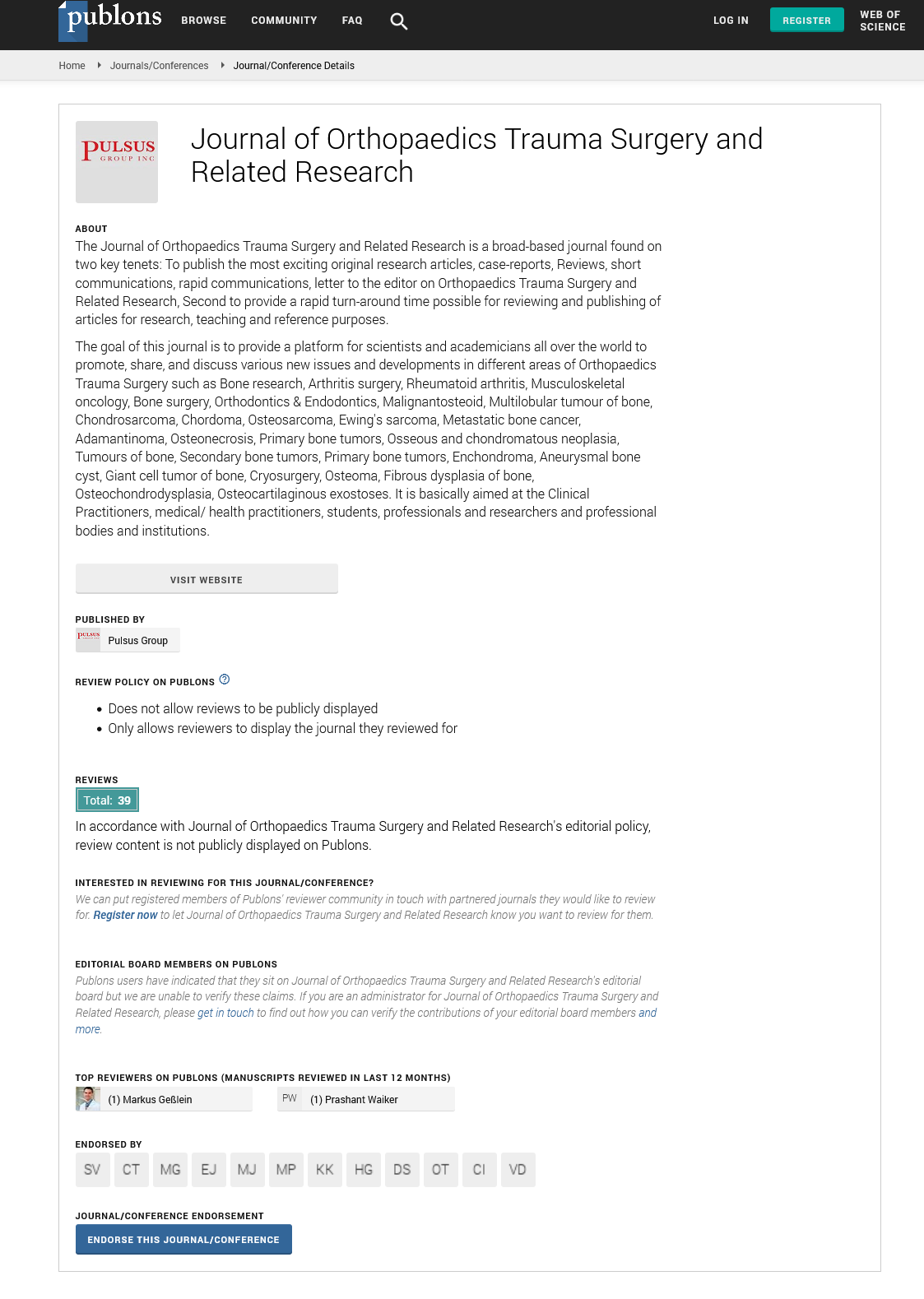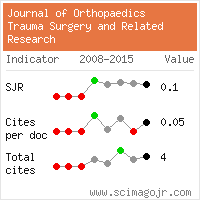Minimum 10 year modular metal-on-metal total performance arthroplasty of the hip
Received: 12-May-2022, Manuscript No. jotsrr-22- 79187; Editor assigned: 13-May-2022, Pre QC No. jotsrr-22- 79187 (PQ); Accepted Date: Jun 09, 2022 ; Reviewed: 27-May-2022 QC No. jotsrr-22- 79187 (Q); Revised: 04-Jun-2022, Manuscript No. jotsrr-22- 79187 (R); Published: 10-Jun-2022, DOI: 10.37532/1897- 2276.2022.17(5).72
This open-access article is distributed under the terms of the Creative Commons Attribution Non-Commercial License (CC BY-NC) (http://creativecommons.org/licenses/by-nc/4.0/), which permits reuse, distribution and reproduction of the article, provided that the original work is properly cited and the reuse is restricted to noncommercial purposes. For commercial reuse, contact reprints@pulsus.com
Abstract
Background: The purpose of this study was to evaluate the long-term outcomes of total hip arthroplasty with a metal-on-metal acetabular prosthesis (at least 10 years). The Pinnacle modular metal-on-metal acetabular prosthesis was used in 89 primary total hip arthroplasties (82 patients). Preoperative and postoperative clinical hip function outcomes were assessed using the Japanese Orthopaedic Association hip score. At the final followup, radiological analysis and magnetic resonance imaging were performed on all hips.
Results: Of the 82 patients who were followed for ten years, 17 were excluded. In the remaining 65 patients (70 hips), 19 (20 hips) developed pseudotumors between 2 and 10 years after surgery. After 10 and 13 years, the revision endpoint survival rates were 93.6% and 90.4%, respectively. At the final follow-up, clinical hip function outcomes had significantly improved. In the radiological analysis, patients who had revision surgery for adverse reactions to metal debris had the highest mean cup angle of inclination and mean ratio of femoral offset on the operated hip to the contralateral hip. Conclusions: The prevalence of pseudotumors in this study was 29.0%. Even ten years after surgery, some cases required revisions. For the early detection of adverse reactions to metal debris, regular clinical surveillance is advised.
Keywords
long-term results; metal-on-metal; pseudotumors; total hip arthroplasty
INTRODUCTION
Total Hip Arthroplasty (THA) is a procedure used to relieve long-term pain in patients with end-stage osteoarthritis of the hip [1, 2]. Despite improved implant designs and surgical techniques, aseptic loosening and osteolysis caused by particulate debris generated by conventional polyethylene have become significant limitations to prosthetic long-term survivorship. With an estimated 1 million hips implanted worldwide in 2000, there was an increasing trend of implantation of large diameter and hard bearing surface prostheses in THA, particularly Metal-On-Metal (MOM). MOM prostheses have perceived advantages such as improved arc of motion, reduced risk of dislocation, lower volumetric wear, and bearing surface durability. Despite the potential benefits, one persistent concern with MOM articulation is the release of metal ion debris in the patients’ blood and urine. Metal debris adverse reactions include the formation of pseudotumors, metallosis, and soft tissue necrosis. Because of ARMD, various MOM THA have had high short-term failure rates. A previous study found that using cobalt chromium molybdenum on cobalt chromium molybdenum on cobalt chromium molybdenum on cobalt chromium molybdenum on cobalt chromium molybdenum Ammarullah MI et al. reported that increasing the body mass index under normal walking conditions increased the Tresca stress value and widened the stress distribution using a 2D finite element representing a CoCrMo-on-CoCrMo hip implant [3-6]. However, research on the long-term outcomes of patients with MOM THA is limited, particularly in terms of ARMD and revision rates. Even if MOM bearing surfaces are no longer used, long-term data could aid in determining the best course of action for these patients. This study intends to look into the long-term clinical outcomes for at least a year.
10 years after total hip arthroplasty with a metal-on-metal acetabular prosthesis, and investigate In Japanese patients, radiological findings, including Magnetic Resonance Imaging (MRI), with a MOM THA of 36 mm
Materilas and Methods
In this retrospective study, we followed up on patients who received cementless MOM THA implants at a single institution between 2006 and 2010. Only the Pinnacle THA system was included in this case. A Pinnacle-A (DePuy, Warsaw, IN, USA) modular acetabular component was used, which consisted of a metal liner (Ultamet; DePuy, Warsaw, IN, USA). The shell was a Pinnacle hydroxyapatite-coated hemispherical implant with a self-locking peripheral taper to accept an Ultamet cobalt-chrome inner diameter metal liner with a 36-mm (cup size: 52 mm and over) or 28-mm (cup size: 50 mm) inner diameter. All patients were fitted with either a 36-mm or a 28-mm Articul/eze femoral cobalt-chrome metal head (DePuy, Warsaw, IN, USA). The femoral stem in all MOM THAs was an S-ROM stem (DePuy, Warsaw, IN, USA). The same equipment and a posterolateral approach were used for all surgical procedures. In terms of primary THA, 89 primary THAs were performed on 82 patients (75 women and 14 men) using a Pinnacle (DePuy, Japan) modular MOM acetabular prosthesis.The majority of patients had osteoarthritis as their preoperative diagnosis. At the time of surgery, the patients’ average age was 62.6 years, their average body weight was 56.7 kg, and their average body mass index (BMI) was 24.2 kg/m2. The Japanese Orthopaedic Association (JOA) hip score was used to evaluate the clinical outcomes of patients who had been followed for at least ten years. An experienced radiologist and orthopaedic surgeon reviewed each patient’s anteroposterior and lateral hip radiographs. The exclusion criterion was a 10-year followup period. Our Institutional Review Board approved this study, and all patients who participated provided informed consent. All procedures were carried out in accordance with the institutional committee’s ethical standards as well as the 1964 Helsinki Declaration and its subsequent amendments.
Statistical Analysis
The nonparametric Wilcoxon signed-rank test, analysis of variance, and Spearman’s rank correlation coefficient were used in the statistical analyses. A p value of 0.05 was regarded as significant. The survivorship of revision and loss of follow-up (including transfer to another hospital and not visited) was analysed using Kaplan-Meier survival as the end point, including patients who died before the 10-year follow-up. IBM SPSS Statistics was used for all statistical analyses (IBM Japan, Tokyo, Japan).
Result
Seventeen patients (19 hips) died before the 10-year follow-up period. After 2.8 years, one patient (both hips) died from pneumonia. After 3.6 and 4 years, two patients (2 hips) died of heart failure. After 7 and 9.5 years, three patients (3 hips) died from medical disease, cerebral aneurysm, or breast cancer, respectively. Because visiting our hospital was difficult, two patients (3 hips) were transferred to another hospital after 9 years and 9.5 years. For unknown reasons, the remaining nine patients (9 hips) did not visit before their 10-year follow-up. After excluding patients who had been followed for at least 10 years, 65 patients (70 hips) were evaluated at the average 13 year follow-up (range, 10 years–15 years). Primary hip osteoarthritis was the reason for primary THA in 89% of patients (59/70 hips) and rheumatoid arthritis in 12.9% (9/70 hips). One patient (1/70 hips) was diagnosed with femoral head avascular necrosis and secondary hip OA after a traumatic fracture. We included 65 hips with a 36 mm diameter Articul/eze femoral head and 5 with a 28 mm diameter head.
Discussion
THA with a large head has perceived benefits such as improved arc of motion and reduced risk of dislocation. However, due to unacceptably high revision rates of large head MOM conventional THA within 10 years of implantation, a large diameter for MOM THA has generally not lived up to clinical expectations. They all have limitations, such as adverse local tissue reaction (ALTR), ARMD, and PTs. MOM THA and ALTR failure was discovered only after these replacements had been in use for several years . The 36-mm MOM Pinnacle THA system (DePuy, Leeds, UK) has been widely implanted around the world. Furthermore, these moderate-to-high survival rates have been confirmed in several large cohort studies examining the 36-mm MOM Pinnacle THA system over 9 years, and Pearce et al over 10 years found survival rates of 84%, 94.4%, and 83.4%, respectively, in large cohort studies. Furthermore, La Haise et al. suggest that MOM hip survivorship may be relatively high (5.4 revisions per 1000 person-years) After 15 years, several small but long-term single-center cohort studies examining the 36 mm MOM Pinnacle THA system confirmed an 83% survival rate [7]. In this study, the overall implant survival rate was 90.4% after a mean of 13 years, with ARMD accounting for 10% of revisions. In Asia, the Pinnacle-A shell is a hydroxyapatite-coated hemi-spherical implant. MOM THA with Pinnacle-A had a higher incidence of osteolysis than ceramic-onceramic THA in a previous report of mid-term results. However, when implant loosening and revision THA were used as endpoints, there was no significant difference in 8-year survival rates between implants. According to Higuchi et al. [8], the incidence of asymptomatic ALTR/ ARMD and PTs ranged between 40% and 60%, with 8.9% experiencing pain or discomfort. In our study, 10% of MOM THAs (7 hips) required revision surgery for symptomatic ARMD, while 20.3% (14 hips) had asymptomatic PTs. The incidence rate of symptomatic PTs was nearly identical, and the rate of asymptomatic PTs was lower than in previous reports. This could be because the asymptomatic PT group had a smaller cup inclination angle and offset compared to the symptomatic ARMD group, which had revision surgery[9].
Conclusion
Clinical scores, such as the JOA score, revealed favourable outcomes after an average 13-year follow-up. The prevalence of PTs per hip, on the other hand, was 29.0%. Even ten years after THA, some cases required revisions. Although this MOM THA has not failed as dramatically as other similar designs, we advise against continuing to use it and instead recommend regular clinical surveillance, such as MRI, for early detection of ARMD.
References
- Phornphutkul C, Introne WJ, Perry MB, et al. Natural history of alkaptonuria. N Engl J Med 2002; 347: 2111-21. [Google Scholar][CrossRef]
- Zannoni VG, Lomtevas N, Goldfinger S. Oxidation of homogentisic acid to ochronotic pigment in connective tissue. Biochim Biophys Acta 1969;177: 94-105 [Google Scholar][CrossRef]
- Lorenzini S, Mannoni A, Selvi E et al. Alkaptonuria. N Engl J Med. 2003; 348(14):1408. [Google Scholar][CrossRef]
- Aydogdu S, Cullu E, Ozsoy MG, et al. Cementless total knee arthroplasty in ochronotic arthropathy: a case report with four-year follow-up. J Arthroplasty 2000;15:539-43. [Google Scholar][CrossRef]
- Carrier DA, Harris CM. Bilateral hip and bilateral knee arthroplasties in a patient with ochronotic arthropathy. Orthop Rev 1990;19:1005-9. [Google Scholar][CrossRef]
- Dom K, Pittevils T. Ochronotic arthropathy, the black hip: case report and review of the literature. Acta Orthop Belg 1997;63:122-5. [Google Scholar][CrossRef]
- Emel E, Karagoz F, Aydin IH, et al. Alkaptonuria with lumbar disc herniation: a report of two cases. Spine 2000;25:2141-4. [Google Scholar][CrossRef]
- Suzuki Y, Oda K, Yoshikawa Y et al. A novel therapeutic trial of homogentisic aciduria in a murine model of alkaptonuria. J Hum Genet 1999;44:74-9. [Google Scholar][CrossRef]
- La Du Jr BN. Are we ready to try to cure alkaptonuria? Am J Hum Genet Apr 1998;62(4):765-7 [GoogleScholar][CrossRef]



 Journal of Orthopaedics Trauma Surgery and Related Research a publication of Polish Society, is a peer-reviewed online journal with quaterly print on demand compilation of issues published.
Journal of Orthopaedics Trauma Surgery and Related Research a publication of Polish Society, is a peer-reviewed online journal with quaterly print on demand compilation of issues published.